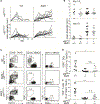Batf3-Dependent Genes Control Tumor Rejection Induced by Dendritic Cells Independently of Cross-Presentation
- PMID: 30482745
- PMCID: PMC12093468
- DOI: 10.1158/2326-6066.CIR-18-0138
Batf3-Dependent Genes Control Tumor Rejection Induced by Dendritic Cells Independently of Cross-Presentation
Abstract
The BATF3-dependent cDC1 lineage of conventional dendritic cells (cDC) is required for rejection of immunogenic sarcomas and for rejection of progressive sarcomas during checkpoint blockade therapy. One unique function of the cDC1 lineage is the efficient cross-presentation of tumor-derived neoantigens to CD8+ T cells, but it is not clear that this is the only unique function of cDC1 required for tumor rejection. We previously showed that BATF3 functions during cDC1 lineage commitment to maintain IRF8 expression in the specified cDC1 progenitor. However, since cDC1 progenitors do not develop into mature cDC1s in Batf3 -/- mice, it is still unclear whether BATF3 has additional functions in mature cDC1 cells. A transgenic Irf8-Venus reporter allele increases IRF8 protein concentration sufficiently to allow autonomous cDC1 development in spleens of Batf3 -/- mice. These restored Batf3 -/- cDC1s are transcriptionally similar to control wild-type cDC1s but have reduced expression of a restricted set of cDC1-specific genes. Restored Batf3 -/- cDC1s are able to cross-present cell-associated antigens both in vitro and in vivo However, Batf3 -/- cDC1 exhibit altered characteristics in vivo and are unable to mediate tumor rejection. These results show that BATF3, in addition to regulating Irf8 expression to stabilize cDC1 lineage commitment, also controls expression of a small set of genes required for cDC1-mediated tumor rejection. These BATF3-regulated genes may be useful targets in immunotherapies aimed at promoting tumor rejection.
©2018 American Association for Cancer Research.
Conflict of interest statement
The authors declare no competing financial interests.
Conflict of interest: The authors declare no potential conflict of interest.
Figures







Similar articles
-
Batf3 maintains autoactivation of Irf8 for commitment of a CD8α(+) conventional DC clonogenic progenitor.Nat Immunol. 2015 Jul;16(7):708-17. doi: 10.1038/ni.3197. Epub 2015 Jun 8. Nat Immunol. 2015. PMID: 26054719 Free PMC article.
-
IRF8 and BATF3 interaction enhances the cDC1 specific Pfkfb3 gene expression.Cell Immunol. 2022 Jan;371:104468. doi: 10.1016/j.cellimm.2021.104468. Epub 2021 Dec 10. Cell Immunol. 2022. PMID: 34968772
-
Peripheral CD103+ dendritic cells form a unified subset developmentally related to CD8alpha+ conventional dendritic cells.J Exp Med. 2010 Apr 12;207(4):823-36. doi: 10.1084/jem.20091627. Epub 2010 Mar 29. J Exp Med. 2010. PMID: 20351058 Free PMC article.
-
Concise review: The heterogenous roles of BATF3 in cancer oncogenesis and dendritic cells and T cells differentiation and function considering the importance of BATF3-dependent dendritic cells.Immunogenetics. 2024 Apr;76(2):75-91. doi: 10.1007/s00251-024-01335-x. Epub 2024 Feb 15. Immunogenetics. 2024. PMID: 38358555 Review.
-
Anatomy of a superenhancer.Adv Immunol. 2024;163:51-96. doi: 10.1016/bs.ai.2024.08.001. Epub 2024 Aug 31. Adv Immunol. 2024. PMID: 39271259 Review.
Cited by
-
An adjuvant-containing cDC1-targeted recombinant fusion vaccine conveys strong protection against murine melanoma growth and metastasis.Oncoimmunology. 2022 Aug 24;11(1):2115618. doi: 10.1080/2162402X.2022.2115618. eCollection 2022. Oncoimmunology. 2022. PMID: 36046810 Free PMC article.
-
Inflammasomes within Hyperactive Murine Dendritic Cells Stimulate Long-Lived T Cell-Mediated Anti-tumor Immunity.Cell Rep. 2020 Nov 17;33(7):108381. doi: 10.1016/j.celrep.2020.108381. Cell Rep. 2020. PMID: 33207188 Free PMC article.
-
Engineering dendritic cell vaccines to improve cancer immunotherapy.Nat Commun. 2019 Nov 27;10(1):5408. doi: 10.1038/s41467-019-13368-y. Nat Commun. 2019. PMID: 31776331 Free PMC article. Review.
-
Models of dendritic cell development correlate ontogeny with function.Adv Immunol. 2019;143:99-119. doi: 10.1016/bs.ai.2019.09.001. Epub 2019 Sep 16. Adv Immunol. 2019. PMID: 31607369 Free PMC article. Review.
-
Are Conventional Type 1 Dendritic Cells Critical for Protective Antitumor Immunity and How?Front Immunol. 2019 Feb 12;10:9. doi: 10.3389/fimmu.2019.00009. eCollection 2019. Front Immunol. 2019. PMID: 30809220 Free PMC article. Review.
References
-
- Torti N, Walton SM, Murphy KM, and Oxenius A. Batf3 transcription factor-dependent DC subsets in murine CMV infection: differential impact on T-cell priming and memory inflation. Eur.J.Immunol. 2011;41:2612–2618. - PubMed
Publication types
MeSH terms
Substances
Grants and funding
LinkOut - more resources
Full Text Sources
Research Materials

